Breakfast

| Part of a series on |
| Meals |
|---|
 |
| Meals |
| Components and courses |
| Related concepts |
Breakfast is the first meal of the day usually eaten in the morning.[1] The word in English refers to breaking the fasting period of the previous night.[2] Various "typical" or "traditional" breakfast menus exist, with food choices varying by regions and traditions worldwide.
History
In Old English, a regular morning meal was called morgenmete,[3] and the word dinner, which originated from Gallo-Romance desjunare ("to break one's fast"), referred to a meal after fasting.[4][5] Around mid-13 century, that meaning of dinner faded away, and around 15th century "breakfast" came into use in written English to describe a morning meal.[2]
Ancient breakfast
Ancient Egypt
In Ancient Egypt, peasants ate a daily meal, most likely in the morning, consisting of soup, beer, bread, and onions before they left for work in the fields or work commanded by the pharaohs.[6]
The traditional breakfast believed to have been cooked in ancient Egypt was fūl (made from fava beans, possibly the ancestor of today's ful medames), baladi bread, made from emmer wheat, and falafel, and a mixture of fava beans with onions, garlic, parsley and coriander.[7]
Ancient Greece
In Greek literature, there are numerous mentions of ariston, a meal taken not long after sunrise. The Iliad notes this meal with regard to a labor-weary woodsman eager for a light repast to start his day, preparing it even as he is aching with exhaustion.[8] The opening prose of the 16th book of the Odyssey mentions breakfast as the meal being prepared in the morning before attending to one's chores.[9] Eventually ariston was moved to around noon, and a new morning meal was introduced.
In the post-Homeric classical period of Greece, a meal called akratisma was typically consumed immediately after rising in the morning.[8] Akratisma (ἀκρατισμός, akratismos) consisted of barley bread dipped in wine (ἄκρατος, akratos), sometimes complemented by figs or olives.[10] They also made pancakes called tēganitēs (τηγανίτης), tagēnitēs (ταγηνίτης).[11] or tagēnias (ταγηνίας),[12] all words deriving from tagēnon (τάγηνον), meaning "frying pan".[13] The earliest attested references on tagēnias are in the works of the 5th century BC poets Cratinus[14] and Magnes.[15][16][17] Another kind of pancake was staititēs (σταιτίτης), from staitinos (σταίτινος), "of flour or dough of spelt",[18] derived itself from stais (σταῖς), "flour of spelt".[19] Athenaeus in his Deipnosophistae mentions staititas topped with honey, sesame and cheese.[20][21][22]
Ancient Rome
Romans called breakfast ientaculum. It was usually composed of everyday staples like bread, cheese, olives, salad, nuts, raisins, and cold meat left over from the night before.[23] They also drank wine-based drinks such as mulsum, a mixture of wine, honey, and aromatic spices.[24] 1st century Latin poet Martial said that ientaculum was eaten at 3:00 or 4:00 in the morning, while 16th century scholar Claudius Saumaise wrote that it was typically eaten at 9:00 or 10:00 a.m. It seems unlikely that any fixed time was truly assigned for this meal.[25]
Roman soldiers woke up to a breakfast of pulmentus, porridge similar to the Italian polenta, made from roasted spelt wheat or barley that was then pounded and cooked in a cauldron of water.[26]
Middle Ages (500–1500)
Europe
This section's factual accuracy is disputed. (June 2021) |
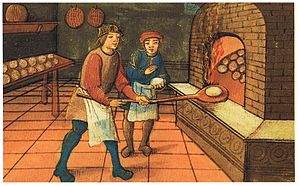
In the European Middle Ages, breakfast was not usually considered a necessary and important meal, and was practically nonexistent during the earlier medieval period. Monarchs and their entourages would spend a lot of time around a table for meals. Only two formal meals were eaten per day—one at mid-day and one in the evening. The exact times varied by period and region, but this two-meal system remained consistent throughout the Middle Ages.
Breakfast in some times and places was solely granted to children, the elderly, the sick, and to working men. Anyone else did not speak of or partake in eating in the morning. Eating breakfast meant that one was poor, was a low-status farmer or laborer who truly needed the energy to sustain his morning's labor, or was too weak to make it to the large, midday dinner.[27]
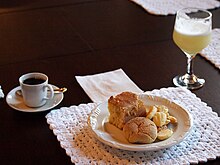
In the 13th century, breakfast when eaten sometimes consisted of a piece of rye bread and a bit of cheese. Morning meals would not include any meat, and would likely include 0.4 imperial gallons (1.8 L) of low alcohol-content beers. Uncertain quantities of bread and ale could have been consumed in between meals.[28]
By the 15th century, breakfast in western Europe often included meat.[29] By this time, noble men were seen to indulge in breakfast, making it more of a common practice, and by the early 16th century, recorded expenses for breakfast became customary. Breakfast in eastern Europe remained mostly the same as the modern day: a "continental breakfast". The 16th century introduction of caffeinated beverages into the European diet was also an addition to breakfast; it was believed that coffee and tea aid the body in "evacuation of superfluities".[30]
Modern breakfast (1500–present)
Africa
Traditionally, the various cuisines of Africa use a combination of locally available fruits, cereal grains and vegetables, as well as milk and meat products. In some parts of the continent, the traditional diet features milk, curd and whey products. A type of porridge is most commonly eaten. In the book The Bible cyclopædia (et al.) published in 1843, it was documented that during this time in the Arab world, Bedouins often utilized locusts mixed with butter for breakfast, spreading the mixture on unleavened bread.[31]
Egypt
In the book The Bible cyclopædia (et al.) published in 1843, it was documented that Egyptians were early risers that sometimes had a first meal consisting of coffee along with the smoking of a pipe, and did not eat breakfast until noon.[32] At this time, it was documented that Egyptian breakfast foods included bread, cheese, eggs, butter, curds, clotted cream and stewed beans.[32] In addition, fava beans are an established national breakfast dish.[33]
Asia
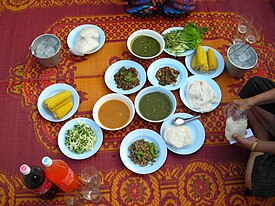
Middle East
In the Middle East region of Asia, Iftar refers to the evening meal when Muslims break their sawm (fast) during the Islamic month of Ramadan. Iftar is one of the religious observances of Ramadan, and is often done as a community, with people gathering to break their fast together. Iftar is done right after Maghrib (sunset) time. During the month of Ramadan, Muslims replace traditional breakfast with suhoor, an Islamic term referring to the meal consumed early in the morning by Muslims before sawm during daylight hours. The meal is eaten before fajr (dawn).[34]

Israel
Japan
In Japan, it is common to eat miso soup and rice porridge for breakfast.[35]
Lebanon
In the book The Bible cyclopædia (et al.) it was documented that c. 1843, poor Lebanese people would consume raw leeks with bread for breakfast.[36]
Europe

Austria
The croissant appears to have originated in Vienna, Austria, in 1683.[37][38]
France

French breakfasts are often similar to the continental breakfast.[39] French breakfast pastries include apple turnovers, brioche, croissant[40] and pain au chocolat.[41] Croissants have been described as becoming a standard fare in French breakfast cuisine by 1875.[40]
Netherlands
Breakfast usually consists of bread with a wide variety of cold cuts, cheeses and sweet toppings; such as hagelslag, vlokken, muisjes, gestampte muisjes, chocolate spread, treacle (a thick, dark brown sugar syrup called stroop), apple butter and peanut butter.
The word waffle derives from the Dutch word wafel, which itself derives from the Middle Dutch wafele,[42] and is likely the origin of the food as it is known today.[43]
United Kingdom
In the early 16th century, some physicians warned against eating breakfast, because they said it was not healthy to eat before a prior meal was digested.[44] By the 1550s, however, there were multiple sources that claimed breakfast was an important meal. For example, in 1551, Thomas Wingfield stated that breakfast was essential. In 1589, Thomas Cogan stated that it was unhealthy to miss breakfast in the morning. He was one of the first to claim that it was healthy for those who were not young, ill or elders to eat breakfast.[45]
The full breakfast is a staple of British cuisine, and typically consists of bacon, sausages and eggs, often served with a variety of side dishes and a beverage such as coffee or tea. Prior to 1600, breakfast in Great Britain typically included bread, cold meat or fish, and ale.[46] Tea, chocolate and coffee were introduced to Great Britain in the mid-1600s, and in the 1700s coffee and chocolate were adopted as breakfast drinks by the fashionable.[46] Tea eventually became more popular than chocolate as a breakfast drink.[46]
North America
The first groups known to have produced maple syrup and maple sugar were indigenous peoples living in the northeastern part of North America. According to aboriginal oral traditions, as well as archaeological evidence, maple tree sap was being processed into syrup long before Europeans arrived in the region.[47][48]
Canada
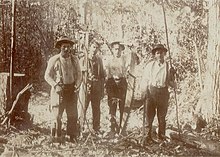
While it has been a source of controversy where the lumberjack breakfast came from, the most cited source is that the lumberjack breakfast was first served in a Vancouver hotel, in 1870. The breakfast consisted of eggs, assorted fried pork strips, and flapjacks. It is said by Anita Stewart that the tradition of hearty cooking developed because of men needing the energy for manual labor.[49]
Mexico
A typical Aztec breakfast often included corn porridge with honey and chillies, or tortillas with beans and salsa.[50]
Chilaquiles are a staple breakfast dish that dates back to the times of the Aztecs; they consist of tortilla chips (locally known as "totopos") slathered in salsa and usually come with a side of refried beans. Depending on the region or person, they may be eaten with fried or scrambled eggs, pulled chicken, sprinkled cheese, crema, diced onion, or chopped cilantro (coriander) leaves.[51] Eggs are also a staple in Mexican breakfasts, scrambled and fried eggs are usually eaten with tortillas, salsa, and beans; local varieties include huevos rancheros and "huevos con tortilla", which are scrambled eggs fried alongside pieces of corn tortillas.
Breakfast cereals are also common in Mexico, mainly due to American influence. Health concerns have arisen regarding the nutritional quality of processed breakfast cereal; it is estimated that Mexican preschoolers consume 7% of their total energy intake from processed breakfast cereals and that 6% of Mexican children exclusively have ready-to-eat cereals with milk for breakfast.[52]
United States
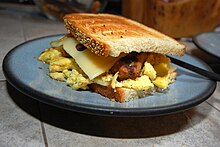
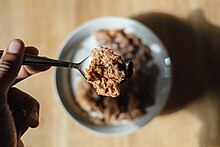
In 1620, waffles were first introduced to North America by pilgrims who had lived in the Netherlands.[53] Later pioneers consumed largely cornmeal-based breakfasts, and would also consume meals such as oatmeal for dinner and lunch.[54] Common breakfast products included corn pone, johnnycakes, ashcakes, hoe-cakes, and corn dodgers.[54] Ashcakes consisted of cornmeal wrapped in cabbage leaves cooked in the ashes of a campfire, while corn pone is baked, corn dodgers are pan fried, and hoe-cakes are similar to pancakes.[54][55] After the American Civil War, it became fairly common in America to eat sandwiches that were made of ham and eggs. These sandwiches were not strictly consumed in the morning. In 1897, the first true breakfast sandwich recipe was published in a cookbook.[56] Popcorn cereal was consumed by Americans in the 1800s, which typically consisted of popcorn with milk and a sweetener.[57] Cold breakfast cereal has been consumed by Americans since the late 1890s, and during the 1920s a considerable number of new cereals were marketed.[58] The reason for this movement towards cold breakfast cereals was inspired by the Jacksonian-era Clean Living Movement (1830–1860). This movement focused on a lot of lifestyle changes, but specific to breakfast it claimed that eating bacon, eggs, pancakes and hot coffee was too indulgent.[59] The first prepared cold breakfast cereal marketed to American consumers was created by Dr. John Harvey Kellogg, who introduced it in 1878 and named it granola.[60] The product was prepared with baked wheat, oatmeal and cornmeal, and was the first brand-name breakfast cereal in the United States.[60]
Canned fruit juice became prominent as a breakfast beverage after the discovery of vitamins.[61] C. 1900, orange juice as a breakfast beverage was a new concept.[60] The development of frozen orange juice concentrate began in 1915, and in the 1930s it was produced by several companies.[62] Additionally, mass-produced tomato juice began to be marketed in the mid-1920s, and became a popular breakfast drink a few years thereafter.[58]
The Caribbean
Haitian spaghetti is a common breakfast dish in Haitian cuisine.[63][64][65][66]
Effect on health
While breakfast is commonly referred to as "the most important meal of the day",[67][68] some contest the positive implications of its "most important" status.[69]
Scientific findings
Some epidemiological research indicates that having breakfast high in rapidly available carbohydrates increases the risk of metabolic syndrome.[70]
Memory was found to be adversely affected in subjects of a study who had not eaten their breakfast (q.v. also Studies using mice under this heading). Intelligence was not affected.[71] Children aged within 8 and 11 years were found to have differing brainwave; EEG activity states, causative to breakfast consumption. Non-breakfasting children were observed to have higher activity of upper and lower theta wave, alpha wave, and delta wave, which indicated a causative relationship of breakfast consumption to memory function in the subjects.[72]
A review of 47 studies associating breakfast to (i) nutrition, (ii) body weight and (iii) academic performance found amongst those who had eaten breakfast: (i) better nutrition profiles, many studies found less weight (ii) irrespective of greater calorific consumption per day, although a number did not find this correlation, (iii) studies suggested a possible link to better academic performance in the breakfast eating groups (q.v. Benton and Parker 1998, under this heading).[73]
The influence of breakfast on managing body weight is unclear.[74][75]
Healthy choice
Present professional opinion is largely in favor of eating breakfast,[67] but skipping breakfast might be better than eating unhealthy foods.[76]
See also
References
- ^ "Breakfast – definition of breakfast". Free Online Dictionary, Thesaurus and Encyclopedia. 2012. Retrieved 28 March 2012.
- ^ a b Anderson, p. 5
- ^ "Breakfast". Etymonline.com. Retrieved 2 February 2013.
- ^ Albala, p. 21
- ^ Paoli, Antonio; Tinsley, Grant; Bianco, Antonino; Moro, Tatiana (28 March 2019). "The Influence of Meal Frequency and Timing on Health in Humans: The Role of Fasting". Nutrients. 11 (4): 719. doi:10.3390/nu11040719. ISSN 2072-6643. PMC 6520689. PMID 30925707.
- ^ Alcock, Joan (2006). Food in the Ancient World. Westport, CT: Greenwood Press. p. 181. ISBN 0-313-33003-4.
- ^ Elnasharty, Tasnim (11 March 2020). "The Most Famous Traditional Egyptian Breakfast—Foul and Falafel". www.arabamerica.com. Retrieved 24 May 2021.
- ^ a b Anderson, p. 9
- ^ Homer (2005) The Odyssey. London: Macmillan. p. 265. ISBN 1909621455
- ^ Flacelière R. La Vie quotidienne en Grèce au temps de Périclès. Paris: Hachette, 1988 (1st edn. 1959). p. 205. ISBN 2-01-005966-2, translated in English as Daily Life in Greece at the Time of Pericles. London: Phoenix Press, 2002 ISBN 1-84212-507-9
- ^ ταγηνίτης, Henry George Liddell, Robert Scott, A Greek-English Lexicon, on Perseus
- ^ ταγηνίας, Henry George Liddell, Robert Scott, A Greek-English Lexicon, on Perseus
- ^ τάγηνον, Henry George Liddell, Robert Scott, A Greek-English Lexicon, on Perseus
- ^ Cratinus, 125, Comicorum Atticorum Fragmenta
- ^ Ricotti, Eugenia Salza Prina (2007) Meals and recipes from ancient Greece. Getty Publications. p. 111. ISBN 0892368764
- ^ Dalby, Andrew (1996) Siren feasts: a history of food and gastronomy in Greece. Routledge. p. 91. ISBN 9780415156578
- ^ Spiller, Gene A. (1991) The Mediterranean diets in health and disease. AVI/Van Nostrand Reinhold. p. 34. ISBN 0442004494
- ^ σταίτινος, Henry George Liddell, Robert Scott, A Greek-English Lexicon, on Perseus
- ^ σταῖς, Henry George Liddell, Robert Scott, A Greek-English Lexicon, on Perseus
- ^ Atheneaus, The Deipnosophists, 646b, on Perseus
- ^ Dalby, Andrew (2003) Food in the ancient world from A to Z. Routledge. p. 71. ISBN 0415232597
- ^ Athenaeus and Olson, S. Douglas (2011) The Learned Banqueters, Volume VII: Books 13.594b-14, Loeb Classical Library. pp. 277–78. ISBN 0674996739
- ^ Albala, p. 20
- ^ Riley, H.T. (1852). The Comedies of Plautus. London: Henry G. Bohn.
- ^ Becker, B. A. (1844). Roman Scenes of the Time of Augustus; With Notes and Excursus Illustrative of the Manners and Customs of the Romans. London: John w. Parker. p. 357.
- ^ Katz, Solomon H. and Weaver, William Woys (2002) Encyclopedia of Food and Culture. Vol 1. p. 244. Charles Scribner & Sons. ISBN 0684805685
- ^ Hammond, P.W. (1993). Food & Feast in Medieval England. Phoenix Mill: Alan Sutton.
- ^ Hicks, M.A. (2001). Revolution and consumption in late medieval England. Woodbridge: Boydell Press.
- ^ Anderson, p. 11
- ^ Anderson, p. 12
- ^ Goodhugh, p. 779
- ^ a b Goodhugh, p. 843
- ^ Bsisu, May (2005). The Arab Table: Recipes and Culinary Traditions. HarperCollins. p. 105. ISBN 0060586141
- ^ "BBC — Schools — Religion — Islam". Retrieved 11 April 2010.
- ^ Kenney-Herbert, Arthur (1885). "Culinary Jottings For Madras". Culinary Jottings, A Treatise for Anglo-Indian Exiles (1).
- ^ Goodhugh, p. 755
- ^ Calvel, Raymond (2001). The Taste of Bread. Springer. p. 141. ISBN 0834216469
- ^ Scott-Hamilton, Carolyn (2012). The Healthy Voyager's Global Kitchen: 150 Plant-Based Recipes From Around the World. Fair Winds. p. 115. ISBN 1610581741
- ^ Kittler, Pamela Goyan; Sucher, Kathryn P. (2007). Food and Culture. Cengage Learning. p. 151. ISBN 049511541X
- ^ a b Clarke, Stephen (2012). 1000 Years of Annoying the French. Open Road Media. p. (unlisted). ISBN 1453243585
- ^ Edelstein, Sari (2010). Food, Cuisine, and Cultural Competency for Culinary, Hospitality, and Nutrition Professionals. Jones & Bartlett Learning. p. 138. ISBN 0763759651
- ^ "Definition of waffle". Merriam-Webster. Retrieved 9 April 2013.
- ^ Duda, Carlene (2007). Beyond Oatmeal: 101 Breakfast Recipes. Cedar Fort. p. 83. ISBN 1599550180.
- ^ Lind, L. R. (1988). On the Care of the Aged; and Maximianus, Elegies on Old Age and Love. Philadelphia: American Philosophical Society. p. 247. ISBN 0871691825.
- ^ Albala, p. 25
- ^ a b c Mason, Laura (2004). Food Culture In Great Britain. pp. 34–35. Greenwood Publishing Group. ISBN 031332798X
- ^ Ciesla, William M (2002). Non-wood forest products from temperate broad-leaved trees. Food and Agriculture Organization of the United Nations. pp. 37, 104. ISBN 978-92-5-104855-9.
- ^ "History". Michigan Maple Syrup Association. Archived from the original on 25 May 2011. Retrieved 20 November 2010.
- ^ "Big Breakfasts, Dinner Dates, Fish & the Dishes Read more: Lumberjack Breakfast – Origin of the Term Lumberjack Breakfast". Esquire. 16 May 2008. Retrieved 8 October 2013.
- ^ "What Did the Aztecs Eat and Drink? Mexican Food of the Middle Ages". Historyhit. 3 May 2020. Retrieved 1 January 2021.
- ^ "Chilaquiles: History & Tradition". 9 December 2016. Retrieved 1 January 2021.
- ^ Nieto, C.; Rincon-Gallardo Patiño, S.; Tolentino-Mayo, L.; Carriedo, A.; Barquera, S. (16 August 2017). "Characterization of Breakfast Cereals Available in the Mexican Market: Sodium and Sugar Content". Nutrients. 9 (8): 884. doi:10.3390/nu9080884. PMC 5579677. PMID 28813010.
- ^ Serna-Saldivar, Sergio O. (2012). Cereal Grains: Laboratory Reference and Procedures Manual. CRC Press. p. 270. ISBN 143985565X
- ^ a b c "History Of Breakfast In America". The Early Show. CBS. 6 November 2009. Retrieved 10 April 2013.
- ^ Hundley, Daniel R (1860). Henry B. Price (ed.). Social Relations in Our Southern States. New York: H. B. Price. p. 87.
- ^ Cook, Maud C. (1897). Breakfast, Dinner, and Supper, or What to Eat and How to Prepare it. Philadelphia: J. H. Moore. p. 328.
- ^ Smith, Andrew F. (1999). Popped Culture: The Social History of Popcorn in America. Univ of South Carolina Press. pp. 57–59. ISBN 1570033005
- ^ a b Drowne, Kathleen Morgan; Huber, Patrick (2004). Nineteen Twenties. Greenwood Publishing Group. p. 122. ISBN 0313320136.
- ^ Lincoln, Mary Johnson (1884). Mrs. Lincoln's Boston Cook Book: What To Do and What Not To Do in Cooking. Boston: Roberts Bros. p. 110.
- ^ a b c Sivulka, Juliann (2011). Soap, Sex, and Cigarettes: A Cultural History of American Advertising. Cengage Learning. pp. 87–90. ISBN 113331113X
- ^ Smith, Andrew F. (2007). The Oxford Companion to American Food and Drink. Oxford University Press. p. 69. ISBN 0195307968.
- ^ Smith, Andrew F. (2013). Drinking History: Fifteen Turning Points in the Making of American Beverages. Columbia University Press. p. (unlisted). ISBN 0231530994
- ^ Lamour, Joseph (26 February 2024). "My mom's Haitian spaghetti recipe started a century ago with an assassination". Today. Retrieved 27 April 2024.
- ^ Long, Lucy M. (17 July 2015). Ethnic American Food Today: A Cultural Encyclopedia. Rowman & Littlefield. pp. 257+. ISBN 978-1-4422-2731-6.
- ^ Wong, Cecily; Thuras, Dylan; Obscura, Atlas (12 October 2021). "Spaghetti with hot dogs for breakfast". Gastro Obscura. Workman. p. 371. ISBN 978-1-5235-0219-6.
- ^ Lorell, Clair (25 May 2021). "Fritai Opens With Haitian Spaghetti and Clairin Cocktails in Treme". Eater New Orleans. Retrieved 27 April 2024.
- ^ a b Giovannini M, Verduci E, Scaglioni S, Salvatici E, Bonza M, Riva E, Agostoni C (2008). "Breakfast: a good habit, not a repetitive custom". J Int Med Res. 36 (4): 613–24. doi:10.1177/147323000803600401. PMID 18652755. S2CID 30558064.
- ^ "Breakfast is 'most important meal'". BBC. 7 March 2003. Retrieved 3 June 2009.
- ^ Carroll AE (23 May 2016). "Sorry, There's Nothing Magical About Breakfast". The New York Times. Retrieved 23 May 2016.
- ^ Maki KC, Phillips-Eakley AK, Smith KN (2016). "The Effects of Breakfast Consumption and Composition on Metabolic Wellness with a Focus on Carbohydrate Metabolism". Adv Nutr. 7 (3): 613S–21S. doi:10.3945/an.115.010314. PMC 4863265. PMID 27184288.
- ^ Benton, D; Parker, P Y (1 April 1998). "Breakfast, blood glucose, and cognition". The American Journal of Clinical Nutrition. 67 (4): 772S–778S. doi:10.1093/ajcn/67.4.772S. PMID 9537627.
- ^ Pivik, R.T.; Tennal, Kevin B.; Chapman, Stephen D.; Gu, Yuyuan (June 2012). "Eating breakfast enhances the efficiency of neural networks engaged during mental arithmetic in school-aged children". Physiology & Behavior. 106 (4): 548–555. doi:10.1016/j.physbeh.2012.03.034. PMID 22504496. S2CID 19638958.
- ^ Rampersaud, Gail C.; Pereira, Mark A.; Girard, Beverly L.; Adams, Judi; Metzl, Jordan D. (May 2005). "Breakfast Habits, Nutritional Status, Body Weight, and Academic Performance in Children and Adolescents". Journal of the American Dietetic Association. 105 (5): 743–760. doi:10.1016/j.jada.2005.02.007. PMID 15883552.
- ^ Leidy HJ, Gwin JA, Roenfeldt CA, Zino AZ, Shafer RS (2016). "Evaluating the Intervention-Based Evidence Surrounding the Causal Role of Breakfast on Markers of Weight Management, with Specific Focus on Breakfast Composition and Size". Adv Nutr. 7 (3): 563S–575S. doi:10.3945/an.115.010223. PMC 4863262. PMID 27184285.
- ^ Sievert K, Hussain SM, Page MJ, Wang Y, Hughes HJ, Malek M, Cicuttini FM (January 2019). "Effect of breakfast on weight and energy intake: systematic review and meta-analysis of randomised controlled trials". BMJ (Clinical Research Ed.). 364: l42. doi:10.1136/bmj.l42. PMC 6352874. PMID 30700403.
- ^ Pifferi, Fabien; Aujard, Fabienne (December 2019). "Caloric restriction, longevity and aging: Recent contributions from human and non-human primate studies". Progress in Neuro-Psychopharmacology and Biological Psychiatry. 95: 109702. doi:10.1016/j.pnpbp.2019.109702. PMID 31325469. S2CID 197404162.
Cited sources
- Albala, Ken (2002). Hunting for Breakfast in Medieval and Early Modern Europe. Devon, UK.
{{cite book}}: CS1 maint: location missing publisher (link) - Anderson, Heather Arndt (2013). Breakfast: A History. AltaMira Press. ISBN 978-0759121652.
- Goodhugh, William; Cooke Taylor, William, eds. (1843). The Bible cyclopædia: or, Illustrations of the civil and natural history of the sacred writings. Oxford University.
Further reading
- Kealey, Terence (2016). Breakfast Is a Dangerous Meal: Why You Should Ditch Your Morning Meal for Health and Wellbeing. London: Fourth Estate. ISBN 978-0008172343. OCLC 994867927.
- History of breakfast
- Breakfast: A History. ISBN 9780759121638
- The English Breakfast: The Biography of a National Meal, with Recipes. ISBN 0857854542
- Eating History: Thirty Turning Points in the Making of American Cuisine. ISBN 0231140932
- Food and Cooking in Victorian England: A History. ISBN 0275987086
- Cuisine and Culture: A History of Food and People. ISBN 1118098757
- Ency Kitchen History ISBN 0203319176 (scroll down in preview)
- A History of Food. ISBN 144430514X
- Southern Food: At Home, on the Road, in History. ISBN 0807844179
- Internal Cleansing, Revised 2nd Edition. ISBN 0307874419
- Corn Meal for Breakfast, Dinner, Supper. ISBN 1149900814
- Albala, Ken (2008). Pancake: A Global History. Reaktion Books.
- History of breakfast cereal
- Handbook of Cereal Science and Technology. ISBN 0824782941
- Chemistry and Technology of Cereals as Food and Feed. ISBN 0442308302
- An Uncommon History of Common Things. ISBN 1426204205
- An Irresistible History of Southern Food: Four Centuries of Black Eyed Peas, Collard Greens, and Whole Hog Barbecue[permanent dead link]. ISBN 1609491939
- Foods and Nutrition Encyclopedia, Volume 1. ISBN 0849389801
- Other sources
- Joie de Vivre: Simple French Style for Everyday Living. ISBN 1439106843.
- Kealey, Terence (2016). Breakfast is a Dangerous Meal: Why You Should Ditch Your Morning Meal For Health and Wellbeing. London: Fourth Estate. ISBN 978-0008172343. OCLC 994867927.
